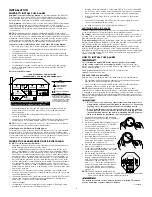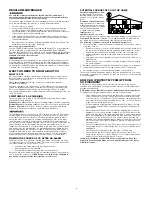
REGULATORY INFORMATION FOR
SMOKE/CO ALARMS
REGULATORY INFORMATION FOR CO ALARMS
WHAT LEVELS OF CO CAUSE AN ALARM?
Underwriters Laboratories Inc. Standard UL2034 requires residential CO
Alarms to sound when exposed to levels of CO and exposure times as
described below. They are measured in parts per million (ppm) of CO over
time (in minutes).
UL2034 Required Alarm Points*:
• If the alarm is exposed to 400 ppm of CO, IT MUST ALARM BETWEEN
4 and 15 MINUTES.
• If the alarm is exposed to 150 ppm of CO, IT MUST ALARM BETWEEN
10 and 50 MINUTES.
• If the alarm is exposed to 70 ppm if CO, IT MUST ALARM BETWEEN
60 and 240 MINUTES.
* Approximately 10% COHb exposure at levels of 15% to 95% Relative
Humidity (RH).
The unit is designed not to alarm when exposed to a constant level
of 30 ppm for 30 days.
CO Alarms are designed to alarm before there is an immediate life threat.
Since you cannot see or smell CO, never assume it’s not present.
•
An exposure to 100 ppm of CO for 20 minutes may not affect average,
healthy adults, but after 4 hours the same level may cause headaches.
•
An exposure to 400 ppm of CO may cause headaches in average, healthy
adults after 35 minutes, but can cause death after 2 hours.
Standards:
Underwriters Laboratories Inc. Single and Multiple Station carbon
monoxide alarms UL2034.
According to Underwriters Laboratories Inc. UL2034, Section 1-1.2: “Carbon
monoxide alarms covered by these requirements are intended to respond to
the presence of carbon monoxide from sources such as, but not limited to,
exhaust from internal-combustion engines, abnormal operation of fuel-fired
appliances, and fireplaces. CO Alarms are intended to alarm at carbon
monoxide levels below those that could cause a loss of ability to react to
the dangers of Carbon Monoxide exposure.” This CO Alarm monitors the air
at the Alarm, and is designed to alarm before CO levels become life threat-
ening. This allows you precious time to leave the house and correct the
problem. This is only possible if Alarms are located, installed, and main-
tained as described in this manual.
Gas Detection at Typical Temperature and Humidity Ranges:
The CO
Alarm is not formulated to detect CO levels below 30 ppm typically. UL tested
for false alarm resistance to Methane (500 ppm), Butane (300 ppm), Heptane
(500 ppm), Ethyl Acetate (200 ppm), Isopropyl Alcohol (200 ppm) and Carbon
Dioxide (5000 ppm). Values measure gas and vapor concentrations in parts
per million.
Audible Alarm: 85dB minimum at 10 feet (3 meters).
REGULATORY INFORMATION FOR SMOKE ALARMS
RECOMMENDED LOCATIONS FOR SMOKE ALARMS
Installing Smoke Alarms in Single-Family Residences
The National Fire Protection Association (NFPA), recommends one Smoke
Alarm on every floor, in every sleeping area, and in every bedroom. In new
construction, the Smoke Alarms must be AC powered and interconnected.
See “Agency Placement Recommendations” for details. For additional cover-
age, it is recommended that you install a Smoke Alarm in all rooms, halls,
storage areas, finished attics, and basements, where temperatures normally
remain between 40˚F (4˚C) and 100˚F (38˚C). Make sure no door or other
obstruction could keep smoke from reaching the Smoke Alarms.
More specifically, install Smoke Alarms:
•
On every level of your home, including finished attics and basements.
•
Inside every bedroom, especially if people sleep with the door partly or
completely closed.
•
In the hall near every sleeping area. If your home has multiple sleeping
areas, install a unit in each. If a hall is more than 40 feet long (12 meters),
install a unit at each end.
•
At the top of the first-to-second floor stairway, and at the bottom
of the basement stairway.
Specific requirements for Smoke Alarm installation vary from state to state
and from region to region. Check with your local Fire Department for current
requirements in your area.
It is recommended AC or AC/DC units be inter-
connected for added protection.
AGENCY PLACEMENT RECOMMENDATIONS
This equipment should be installed in accordance with NFPA (National Fire
Protection Association) 72 and 101. National Fire Protection Association,
One Batterymarch Park, Quincy, MA 02269-9101.
Additional local building and
regulatory codes may apply in your area. Always check compliance require-
ments before beginning any installation.
Standards:
Underwriters Laboratories Inc. Single and Multiple Station Smoke
Alarms 217.
NFPA 72 (National Fire Code)
Smoke Alarms shall be installed in each separate sleeping room, outside each
sleeping area in the immediate vicinity of the bedrooms and on each additional
story of the family living unit, including basements and excluding crawl spaces
and unfinished attics.
In new construction, Alarms shall be so arranged that operation of any one
Alarm shall cause the operation of all Alarms within the dwelling.
Smoke Detection-Are More Smoke Alarms Desirable?
The required number
of Smoke Alarms might not provide reliable early warning protection for those
areas separated by a door from the areas protected by the required Smoke
Alarms. For this reason, it is recommended that the householder consider the
use of additional Smoke Alarms for those areas for increased protection. The
additional areas include the basement, bedrooms, dining room, furnace room,
utility room, and hallways not protected by the required Smoke Alarms. The
installation of Smoke Alarms in kitchens, attics (finished or unfinished), or
garages is not normally recommended, as these locations occasionally experi-
ence conditions that can result in improper operation.
California State Fire Marshal (CSFM)
Early warning detection is best achieved by the installation of fire detection
equipment in all rooms and areas of the household as follows: A Smoke Alarm
installed in each separate sleeping area (in the vicinity, but outside bedrooms),
and Heat or Smoke Alarms in the living rooms, dining rooms, bedrooms,
kitchens, hallways, finished attics, furnace rooms, closets, utility and storage
rooms, basements, and attached garages.
5
ABOUT SMOKE ALARMS
Battery (DC) operated Smoke Alarms:
Provide protection even when elec-
tricity fails, provided the batteries are fresh and correctly installed. Units are
easy to install, and do not require professional installation.
AC powered Smoke Alarms:
Can be interconnected so if one unit senses
smoke, all units alarm. They do not operate if electricity fails.
AC with bat-
tery (DC) back-up:
will operate if electricity fails, provided the batteries are
fresh and correctly installed. AC and AC/DC units must be installed by a
qualified electrician.
Smoke/CO Alarms for Solar or Wind Energy users and battery backup
power systems:
AC powered Smoke/CO Alarms should only be operated
with true or pure sine wave inverters. Operating this Alarm with most battery-
powered UPS (uninterruptible power supply) products or square wave or
“quasi sine wave” inverters
will damage the Alarm
. If you are not sure about
your inverter or UPS type, please consult with the manufacturer to verify.
Smoke Alarms for the hearing impaired:
Special purpose Smoke Alarms
should be installed for the hearing impaired. They include a visual alarm and
an audible alarm horn, and meet the requirements of the Americans With
Disabilities Act. Can be interconnected so if one unit senses smoke, all
units alarm.
All these Smoke Alarms are designed to provide early warning of fires if
located, installed and cared for as described in the user’s manual, and if
smoke reaches the Alarm. If you are unsure which type of Smoke Alarm to
install, refer the National Fire Protection Association (NFPA) Standard 72
(National Fire Alarm Code) and NFPA 101 (Life Safety Code). National Fire
Protection Association, One Batterymarch Park, Quincy, MA 02269-9101.
Local building codes may also require specific units in new construction or
in different areas of the home.
INSTALLING SMOKE ALARMS IN MOBILE HOMES
For minimum security install one Smoke Alarm as close to each sleeping area as
possible. For more security, put one unit in each room. Many older mobile homes
(especially those built before 1978) have little or no insulation. If your mobile
home is not well insulated, or if you are unsure of the amount of insulation, it is
important to install units on inside walls only. Smoke Alarms should be installed
where temperatures normally remain between 40˚F (4˚C) and 100˚F (38˚C).

























